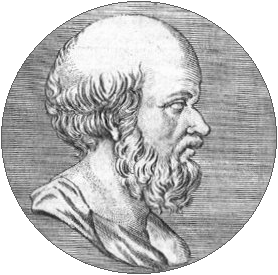“More wine?”
“Hmm? Oh, yes, thank you. Sorry, I was–”
“Thinking about mathematics, I wager. Prime numbers was it?”
“No, just distracted. It’s this blasted heat.”
“It is the longest day of the year.”
“Yes, but normally not so hot.”
“Especially here. You think this is hot, visit me in Syene sometime. You think it gets hot here… You would melt in Syene in the summer.”
“So I hear. I suppose it’s the moderating influence of the ocean that keeps us cooler.”
“That, and we’re closer to the Sun.”
“What?”
“It’s true. Today in Syene, the Sun will be directly overhead at mid-day, while you still have shadows. That places us closer to the sun in its course.”
“That’s impossible.”
“It’s true. Why, at midsummer, you can see the sun reflected in the water at the bottom of a deep well.”
“Truly?”
“I’ve done it myself. If you lean over properly, you can block it with your head, and see your head wreathed in light, like a god. It’s a popular game with children. In a few hours, they’ll be fishing two or three of them out of cisterns in the city– it happens every summer.”
“So…”
“So, the sun must run directly over us, and south of you, of course. Which places us closer to the sun, thus the greater heat.”
“But… That would require the Sun to be only a few times as far from us as the distance from Alexandria to Syene. But we know the distance is far greater than that– the Sun is farther from the Earth than the Moon, after all…”
“Well, what alternative is there?”
“What alternative, indeed? Hmm….”
“…”
“Perhaps instead there’s a difference in the direction… If the Earth were… a sphere… Oh!”
“Wait, where are you going?”
“To my house. To the Library. I must make measurements, do some calculations!”
“But…”
“Thank you for the wine!”
“Hmmph. Philosophers.”
To this point, at least, I’m doing these in something resembling chronological order, and now we’ve skipped ahead to a time where we have some written records. The above slightly clumsy dialogue is, of course, an imagining of the story of Eratosthenes measuring the circumference of the Earth based on the lengths of shadows at noon. It’s a very simple measurement, one that Rhett and I duplicated a few years back, when I was teaching my course on the science of timekeeping.
The story is that Eratosthenes heard from travelers that at noon on the summer solstice, the sun is directly overhead in Syene in southern Egypt (near the modern city of Aswan), while at his home in Alexandria, it was still somewhat south of the zenith. He measured the angle of the midday sun, and found it to be around 7 degrees, roughly 1/50th of a full circle. Treating the Earth as a sphere, he estimated its circumference as fifty times the distance between Syene and Alexandria, which was known from caravan traffic between the two. Alexandria to Syene is 5000 stadia, so the circumference of the Earth is about 250,000 stadia. Of course, nobody today knows exactly how many stadia make up a kilometer, but if you put in the best possible value, he was within a couple of percent of the correct modern value; the worst is off by about 16%. Which is pretty damn good for a measurement using a stick in the sun and some travelers tales.
I’ve taken a bit of liberty above in putting a false argument into the mouth of Eratosthenes’s imaginary friend from Syene– a fine tradition in pop-science writing. I don’t know enough about the state of Greek philosophy in 200 BCE to know whether the Earth was commonly believed to be flat, or a sphere. At around the same time, Aristarchus of Samos was promoting a heliocentric cosmology, and had measured the distance between the Earth and Sun to be much greater than the distance between the Earth and the Moon. That probably assumes Earth as a sphere, so Eratosthenes may well have been simply refining an earlier idea. But we don’t know for sure, most of his books having been lost in the destruction of the Library of Alexandria (of which he was the director, for a time, probably a pretty sweet job to have…).
This is another nice demonstration of the essential simplicity of science. We think of science as something requiring tons of expensive equipment, but the real key is just keeping an eye on small details and thinking through the implications. If you do that, you can make some amazing discoveries with just a stick in the ground and a friend from a different latitude.
————
(Part of a series promoting Eureka: Discovering Your Inner Scientist, available from Amazon, Barnes and Noble, IndieBound, Powell’s, and anywhere else books are sold.)

Around 200 BCE it was generally accepted by educated Greeks that the world was a sphere and had been so for at least 200 years and probably for 400 years ;))
Your friendly neighbourhood #histsci pedant.
As Thony says, by 200 BCE the spherical earth was no longer avant-garde.
As I said, some dramatic liberties were taken here…